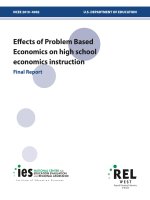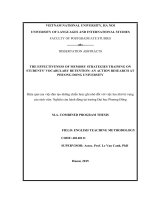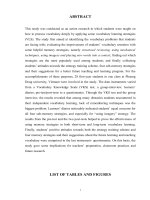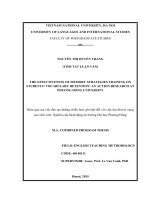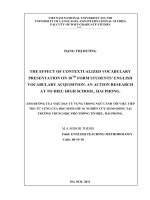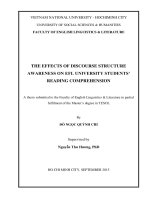THE EFFECTS OF METACOGNITIVE STRATEGIES TRAINING ON HIGH SCHOOL STUDENTS’ ENGLISH LANGUAGE PERFORMANCE
Bạn đang xem bản rút gọn của tài liệu. Xem và tải ngay bản đầy đủ của tài liệu tại đây (560.04 KB, 120 trang )
HANOI UNIVERSITY
DEPARTMENT OF POST GRADUATE STUDIES
THESIS
THE EFFECTS
OF METACOGNITIVE STRATEGIES TRAINING
ON HIGH SCHOOL STUDENTS’ ENGLISH
LANGUAGE PERFORMANCE
STUDENT: TRAN THU THAO
HANOI - 2009
1
HANOI UNIVERSITY
DEPARTMENT OF POST GRADUATE STUDIES
THESIS
THE EFFECTS
OF METACOGNITIVE STRATEGIES TRAINING
ON HIGH SCHOOL STUDENTS’ ENGLISH
LANGUAGE PERFORMANCE
SUPERVISOR: ASSOC. PROF. DR. VO DAI QUANG
STUDENT: TRAN THU THAO
HANOI - 2009
2
ACKNOWLEGEMENTS
I would like to acknowledge and express my gratitude to my supervisor Assoc.
Prof. Dr. Vo Dai Quang for his insightful comments and contructive
supervision throughout my research.
I especially wish to thank Ms. Nguyen Thai Ha for her valuable guidance,
encouragement in the very first step of my thesis.
I also wish to thank all the staff members of the Department of Post graduate,
Hanoi University for providing me best conditions to fulfill my thesis.
I would like to acknowledge and express my appreciation to the administrators
of Long My high school for their constant support and concern while the work
was in progress.
My special thanks are also sent to my colleagues at Long My high school who
have helped me with data collection for this study.
Finally, I am deeply indebted to all the support and encouragement that my
family has offerred me.
3
ABSTRACT
This study aims at examining the effects of metacognitive strategies training on
the autonomy in language learning of high school students.
To serve this purpose, an experiment was carried out at a high school in
Mekong Delta. The participants were 60 students of grade 11 who were chosen
from two random classes in this high school. There were 30 students in the
control group and the same number were in the experimental group.
Before the experiment, the MAI questionnaire was exploited to measure
students’ metacognitive awareness which was utilized as the base for dividing
students into groups.
Then, the experiment was carried out in 10 weeks. During the experiment, the
experimental group were trained with 10 metacognitive strategies organized by
Oxford (1990). The ten strategies chosen for training are ‘overviewing and
linking with already known material’, ‘paying attention’, ‘finding out about
language learning’, ‘organizing’, ‘setting goals and objectives’, ‘identifying
the purpose of a language task’, planning for a language task’, ‘seeking
practice opportunities’, ‘self monitoring’, ‘self-evaluating’. The instruction was
explicit and the training course was seperated from the main course of high
school educational system.
The data collected from the MAI questionnaire, the invetory of metacognitive
use and the tests in pre- and post-stage were computed and analyzed using
paired-sample t-test, SPSS version 16.0.1.
The major findings of the study showed that explicit metacognitive strategies
training helped students improve their autonomy in language learning as well
as their language performance. It was concluded from the findings that
metacognitve strategies were useful to high school students and the use of
metacognitive strategies helped students improve their language performance.
4
TABLE OF CONTENTS
ACKNOWLEGEMENTS............................................................................................3
ABSTRACT..................................................................................................................4
TABLE OF CONTENTS.............................................................................................5
LIST OF ABBREVIATIONS......................................................................................7
LIST OF TABLES.......................................................................................................8
LIST OF FIGURES.....................................................................................................9
CHAPTER 1: INTRODUCTION.............................................................................10
1.1 Background to the study..................................................................................10
1.2 Aims and Objectives of the study...................................................................12
1.2.1 Aims.............................................................................................................12
1.2.2 Objectives....................................................................................................12
1.3 Scope of the study.............................................................................................12
1.4 Significance of the study..................................................................................13
1.5 Organization of the thesis................................................................................13
CHAPTER 2: LITERATURE REVIEW.................................................................15
2.1 Language learning strategies...........................................................................15
2.1.1 Definition....................................................................................................15
2.1.2 Classification..............................................................................................16
2.1.3 Metacognitive strategies.............................................................................18
2.2 Language learning strategy instruction.........................................................21
2.2.1 The role of language learning strategies instruction..................................21
2.2.2 Studies related to metacognitive strategies instruction..............................21
2.2.3 Types of language learning strategy instruction........................................24
2.2.4 Models for language learning strategy instruction....................................25
2.2.5 Language issue in language learning strategy instruction.........................26
2.2.6 The role of teachers in language learning strategy instruction..................27
2.3 Summary...........................................................................................................27
CHAPTER 3: METHODOLOGY............................................................................29
3.1 Research questions and description of variables...........................................29
3.1.2 Description of variables..............................................................................29
3.2 Data collection instruments.............................................................................30
3.2.1 Questionnaires............................................................................................30
3.2.2 Tests............................................................................................................33
3.3 Subjects of the study........................................................................................36
Description.......................................................................................................36
Group assignment............................................................................................37
3.4 Metacognitive strategy instruction.................................................................38
3.4.1 Ways of providing strategy instruction.......................................................38
3.4.2 Language of instruction..............................................................................38
3.4.3 Model for language learning strategy instruction......................................38
3.4.4 The materials used in the experiment.........................................................39
3.4.5 The instructor..............................................................................................40
3.5 Data collection procedures..............................................................................40
3.6 Data analysis.....................................................................................................41
3.6.1 Questionnaire data analysis.......................................................................42
3.6.2 Test data analysis........................................................................................42
3.7 Coding scheme for the use of metacognitive strategies ................................42
5
CHAPTER 4: RESULTS AND DISCUSSION........................................................43
4.1 The results and discussion of the questionnaires...........................................43
4.1.1 The results of the MAI questionnaire..........................................................43
4.1.2 The results of the inventory of metacognitve use........................................48
4.1.3 Discussion of the results of the questionnaires...........................................50
4.2 The results and discussion of the tests............................................................51
4.2.1 The test results within groups.....................................................................52
4.2.2 The test results between groups..................................................................55
4.2.3 Discussion of the test results.......................................................................57
CHAPTER 5: IMPLICATIONS AND CONCLUSIONS.......................................59
5.1 Implications.......................................................................................................59
5.2 Limitations of the study and recommendations for further research.........60
5.2.1 Limitations of the study...............................................................................60
5.2.2 Recommendations for further research......................................................61
5.3 Conclusions.......................................................................................................61
REFERENCES...........................................................................................................63
APPENDICES............................................................................................................70
APPENDIX 1: Oxford’ s Strategy Classification System (Source: Oxford, 1990)
..................................................................................................................................70
APPENDIX 2: CODING SCHEME FOR THE USE OF METACOGNITIVE
STRATEGIES .......................................................................................................72
APPENDIX 3. THE MAI QUESTIONNAIRE (Vietnamese version)...............74
APPENDIX 4. THE MAI QUESTIONNAIRE (English version)......................77
APPENDIX 5. THE PRETEST.............................................................................81
APPENDIX 6. THE INVENTORY OF METACOGNITIVE STRATEGIES
USE (PRE-STAGE)................................................................................................86
APPENDIX 7. THE POST-TEST.........................................................................88
APPENDIX 8. THE INVENTORY OF METACOGNITIVE STRATEGIES
USE (POST-STAGE).............................................................................................93
APPENDIX 9. THE THE TEST RESULTS........................................................96
APPENDIX 10. THE RESULTS OF THE MAI QUESTIONNAIRES............98
APPENDIX 11. THE RESULTS OF THE INVENTORY OF
METACOGNITIVE STRATEGIES USE.........................................................101
APPENDIX 12. TABLES....................................................................................103
6
LIST OF ABBREVIATIONS
CALLA: Cognitive Academic Language Learning Approach
CG: Control Group
EG: Experimental Group
ESL: English as a second language
IMU: Inventory of Metacognitive Use
LLS: Language learning strategy
LLSI: Language learning strategy instruction
LLSs: Language learning strategies
L1: First language
L2: Second language
M: Mean
MAI: Metacognitive Awareness Inventory
MOET: Ministry of Education and Training
P: Probability value
SD: Standard Deviation
SILL: Strategy Inventory for Language Learning
7
LIST OF TABLES
Table 4.1. The correlation of the control group and the experimental group
Table 4.2. The metacognitive awareness of the control group in the pre- and
post-stages
Table 4.3. The differences in metacognitive awareness between pre-stage and
post-stage of the control group
Table 4.4. The metacognitive awareness of the experimental group in the preand post-stages
Table 4.5. The differences in metacognitive awareness between pre-stage and
post-stage of the experimental group
Table 4.6. The total results of the MAI questionnaire between CG and EG
Table 4.7. The differences in the resutls of the MAI questionnaire between CG
and EG
Table 4.8. The section results of the MAI questionnaire between the CG and
EG
Table 4.9.The diffrerences in the resuts of the MAI questionnaire between CG
and EG
Table 4.10. The results of the inventory of metacognitve use of the CG
Table 4.11. The differences in the results of the inventory of metacognitve use
between the pre-stage and post-stage of the CG
Table 4.12. The results of the inventory of metacognitve use of the EG
Table 4.13. The differences in the results of the inventory of metacognitve use
between the pre-stage and post-stage of the EG
Table 4.14. The results of the inventory of metacognitive use of CG and EG
Table 4.15. The differences in the results of the inventory of metacognitve use
between the pre-stage and post-stage of the EG
Table 4.16. The test results of the control group
Table 4.17. The differences in the test results between the pre-stage and poststage of the control group
Table 4.18. The test results of the experimental group
Table 4.19. The differences in the test results between the pre-stage and poststage of the experimental group
Table 4.20. The test results of the CG and the EG
Table 4.21. The differences in the test results between CG and EG
8
LIST OF FIGURES
Figure 4.1. The results of the MAI questionnaire of the control group
Figure 4.2. The results of the MAI questionnaire of the experimental group
Figure 4.3. The results of the MAI questionnaire between CG and EG
Figure 4.4. The section results of the MAI questonnaire between CG and EG
Figure 4.5.The results of the inventory of metacognitve use of the CG
Figure 4.6. The results of the inventory of metacognitve use of the EG
Figure 4.7. The total results of the IMU questionnaire bettween CG and EG
Figure 4.8. The results of the inventory of metacognitve use
Figure 4.9. The test results of the control group
Figure 4.10 The test results of the experimental group.
Figure 4.11. The overall test results between CG and EG
Figure 4.12. The section test resuls between CG and EG
9
CHAPTER 1: INTRODUCTION
1.1 Background to the study
Since many years ago, with the integration and globalization policy of the
government in order to keep up with the rapid development of the world,
English subject has been considered very important in the field of education.
Recently, English subject has become compulsory for high school students. It
has also been an obligatory subject in the final exam, along with Mathematics
and Literature.
In the acknowledgement of the importance of this subject, specialists in
language teaching have paid much attention to discovering and applying new
methods for teaching English as a foreign language with the hope of helping
learners acquire and learn English more effectively. However, the unexpected
results, which were reported by the MOET in English subject in the final exams
in the past few years, are of the visible evidences for the failure of high school
students in acquiring English as a second language. The causes may derive
from many factors. Rubin (1975) argues that many language teachers are so
concerned with finding the best method or with getting the correct answer that
they fail to pay attention to the learning process (Rubin, 1975). Vietnamese
teachers may be in such a situation. Dansereau (1978) also recognizes that the
over-emphasis on teaching methods may convey serious limitations such as
inadvertent reinforcement of ineffective and non-transferable learner strategies.
Some additional problems can be found from the students’ part. Firstly,
Vietnamese students seem to train and to be trained so many skills for their
language performance but the skill to self-direct themselves in language
learning is not paid much attention to. They may have very little of the ability
of planning, arranging, focusing, and evaluating their own learning. The view
that Vietnamese students tend to be passive, obedient and quiet is also accepted
by most of high school teachers. Secondly, a large number of high school
teachers of English acknowledge that students are highly interested in English
10
subject. Most high school students show their understanding of the currently
taught lessons through post activities, which are carried out to measure how
well the students understand the lesson. However, they usually fail with the
progress tests taken a few weeks later. We incline to the fact that they study
with little or without plan.
Besides, the load of the curriculum is one of the remarkable factors. It is
complained by both teachers and students that the class time is not sufficient
for the teachers to carry out any activities relevant to the lessons. What happen
in the classroom just stick to the compulsory contents in the textbooks.
Students are given no chance or very little chance learning how to control their
learning, how to manage the time to study, how to self-direct themselves to
become better learners and so on.
The findings have urged the researcher to seek for the solutions and then she
has found that many of previous studies have shown the relationship between
metacognitive strategies and learners’ autonomy as well as language learning
acquisition (see, for example, Cao (2007), Gimeno (2002),
Kato (2005),
Kincannon (1999), Maraco (2001), O’Malley (1987)).
Research in metacognition suggested that making students aware of these
strategies may be useful, that students can develop strategies on their own, and
that their use increases learning and performance (Blakey, 1990).
It is also stated in Wenden (1987) that one of the “leading” educational goals of
the research on learner strategies is an autonomous language learner. The
strategy training activities can help learners become not only more efficient at
learning and using their second language but also more capable of selfdirecting their endeavors. (ibid: 8). Guided practice in managing their own
experience allows students to develop the metacognitive strategies needed to
continue to direct their own learning (Metcalfe and Shimamura, 1994).
Graham (1997) confirmed that metacognitive strategies, which allow students
to plan, control and evaluate their learning, have the most central role to play in
11
improvement of learning. Anderson (2002b) supported to our beliefs with the
idea that developing metacognitive awareness may also lead to the
development of stronger cognitive skills.
The facts stated show that there is a necessity of improving students’ autonomy
in language learning so that they can control their learning themselves, which
can help them acquire language better. Metacognitive strategies training will be
recommended in this situation with the belief that teaching learners strategies
explicitly at the very first stage of the language lessons will give students a
good direction on their future learning. It is also believed that training students
these skills is a need to help them get better results and manage well with such
a difficult subject like English.
1.2 Aims and Objectives of the study
1.2.1 Aims
The purpose of this study is to examine the effects of metacognitive strategies
training on high school students’ language performance.
1.2.2 Objectives
The objectives of this study are stated as follows.
The first objective is to explore the differences in the degree of metacognitive
awareness as well as metacognitive use before and after the experiment.
The second objective is to examine students’ progess in English language
acquisition via the application of metacognitive strategies.
1.3 Scope of the study
This study focuses only on metacognitive strategies for high school students as
indicated in the tittle of the thesis because there is a limitation of time and
conditions. The subjects of this study are students of grade 11. Besides, the
outcomes of high school students are mostly evaluated by the written tests.
12
Therefore, written tests which focus mainly on the subskills such as
pronunciation, vocabulary, reading, grammar, and short writing will be the
major means to measure the hypothesis coming from the present study.
1.4 Significance of the study
In this study, both teachers and students have taken advantages from the
strategies training. On the students’ part, learning strategy instruction has
helped learners in three ways. Firstly, learning strategies instruction helps
students to become better English learners . Secondly, skills in using learning
strategies assist them in becoming independent and confident learners. Finally,
they become more motivated as they begin to understand the relationship
between their use of strategies and success in learning languages (see more in
chapter 4). On the teacher’s part, the researcher herself finds that when using
strategy training often, she becomes enthusiastic about her roles as the
facilitator of classroom learning. Strategy training also makes the teacher more
learner-oriented and more aware of her students’ needs. During the training, the
teacher, additionally, begins to scrutinize how the teaching techniques relate or
fail to relate to the students’ learning strategies and sometimes the teacher
chooses to alter the instructional patterns because of such ‘scrutiny’ (Oxford et
al., 1999, p.210).
1.5 Organization of the thesis
This thesis is organized in five chapters described as follows.
Chapter 1, ‘Introduction’, deals with the background, aims and objectives,
scope, significance and the outline of this study.
Chapter 2, ‘Literature Review’, provides readers with the definitions of the
term ‘language learning strategies’. The information about language learning
strategy instruction is also collected in this part, including presentation in the
roles of LLSI in language learning, studies related to metacognitive instruction,
types of LLSI, models of LLSI, language issue in LLSI, and the role of
13
teachers in LLSI as well. A short summary about how the researcher applies
the literature for the study is also mentioned at the end of this part.
Chapter 3 presents the methodology for this study and the procedure for
carrying out the reasearch.
Chapter 4 exposes the results through data analysis . The results of the data
analysis were, then, discussed and compared with those obtained in previous
studies.
Chapter 5 provides the implications, limitations, and reccomendations for
further research. The next important section in this chapter is the conclusions to
the whole study. And the last one is the references.
The appendices of this thesis consists of Oxford’s Strategy Classification
System, the coding scheme for the use of Metacognitive Strategies, the
Questionaire (English and Vietnamese version), results of the questionaires and
the tests, and the pre-test and posttest.
14
CHAPTER 2: LITERATURE REVIEW
2.1 Language learning strategies
This section will provide readers with the definitions, the classification from
different viewpoints on language learning strategies, and the information about
metacognition.
2.1.1 Definition
People have been writing about and conducting research into learner strategies
for about 20 years now. However, what learner strategies actually are has been
difficult to define at an international level with full consensus (Macaro, 2001).
There have been several definitions of language learning strategies developed
until now.
Weinstein and Mayer (1986) stated that learning strategies are ‘the behaviour
and thought’ that a learner engages in during learning that are intended to
influence the learner's encoding process.
Lately, Charnot (1987) supported one more definition when considering
language-learning strategies as techniques, approaches or deliberate actions
that students take in order to facilitate the learning and recall of both linguistic
and content area information.
Wenden (1987) argued that learner strategies refer to ‘language learning
behaviour learners actually engage in to learn and regulate the learning of a
second language’, ‘what they know about the strategies they use’, ‘what they
know about the aspects of their language learning other than the strategies they
use’.
Oxford (1990) defined language-learning strategies as ‘specific actions taken
by the learner to make learning easier, faster, more enjoyable, more selfdirected, and more effective and more transferable to new situations.’
15
In 1998, Cohen offered another definition as second language learning
strategies ‘encompass’ both second language learning and second language use
strategies. When taken together they constitute the steps or actions consciously
selected by learners either for the learning of a second language, the use of it,
or both (Cohen, 1998).
Although there have been a variety of definitions stated and after Cohen’s
(1998), some more definitions on language learning strategies have been
developed. The definition of Oxford (1990) will be exploited as the base for the
present study, for her definition is clear, concrete and its categories are suitable
and applicable to high school students.
2.1.2 Classification
The concentration of work on language learning strategies has been not only
with defining strategies but also with classifying them. The classification of
language learning strategies is varied by many scholars such as O'Malley et al
(1985), Wenden (1987), Oxford (1992), Stern (1992), and Ellis (1994).
What follow is the
summarization
of the language learning strategies
classifications of some authors who shared more or less the same
categorizations of the language learning strategies without any radical changes.
As a pioneer, Rubbin (1987) classified language-learning strategies into three
types: learning strategies, communicative strategies and social strategies.
Learning strategies are defined as strategies contributing directly to the
development of the language system constructed by the learner. This kind of
strategies consists of two subcategories: cognitive learning
strategies and
metacognitive strategies in which cognitive learning strategies refer to ‘the
steps or operations used in learning or problem –solving that require direct
analysis,
transformation,
or
synthesis
of
learning
materials’
while
metacognitive strategies are used to ‘oversee, regulate or self direct language
learning’.
16
The second type of language learning strategies in Rubin’s classification,
which is communicative strategies on the process of participating in a
conversation, consists of getting meaning across and classifying what the
speaker carried in their minds.
Social strategies, the third type of language learning strategies in this case, are
related to the social aspect of language learning. This kind of strategies shows
the ability to take part in some activities that give chances to be exposed to and
to practise their knowledge.
In Oxford’s (1990) classification of language learning strategies, she aimes
language-learning strategies at the development of communicative competence.
That is the reason why Oxford divided language-learning strategies into two
main groups: direct strategies and indirect strategies.
The direct strategies are consequently subdivided into three categories:
memory, cognitive and compensation strategies. With the memory strategies,
learners will know how to create mental linkage, how to apply images and
sound, how to review well and how to employ action. Whilst, the cognitive
strategies will support to learners with the abilities to practice, to receive and
send messages, to analyse and reason, and to create structure for input and
output. Whereas, the compensation strategies will help learners with guessing
intelligently and overcoming limitations in speaking and writing.
The indirect strategies, on the other hand, convey three other major issues:
metacognitive strategies, affective strategies and social strategies. In this
section, the metacognitive strategies play the role of helping center learners’
learning, arrange and plan learners’ learning and evaluate learners’ learning;
affective strategies will encourage learners themselves, make their anxiety
lower and increase their emotional temperature; and social strategies will offer
learners opportunities to ask questions, to cooperate with others and to
empathize with others.
17
2.1.3 Metacognitive strategies
What does it mean by metacognitive strategies?
Metacognitive strategies along with affective strategies and social strategies are
among the subcategories of indirect strategies arranged by Oxford (1990).
‘Metacognitive’ means beyond, beside, or with the cognitive.
Therefore, metacognitive strategies are actions which go beyond
purely cognitive devices, and which provide a way for learners to
coordinate their own learning process. Metacognitive strategies
include three strategy sets: Centering your learning, Arranging and
Planning your learning, and Evaluating your Learning.
(Oxford, 1990, p.136)
In Oxford’s classification, the three sets of metacognitive strategies contain
eleven other strategies. They consist of overviewing and linking with already
known material, paying attention, delaying speech production to focus on
listening, finding out about language learning, organizing, setting goals and
objectives, identifying the purpose of a language task, seeking practice
opportunities, self-monitoring, and self-evaluating.
Nevertheless, only ten of those are put in consideration for training in this
study. The strategy of delaying speech production to focus on listening seems
to be out of ability of high school student to accomplish.
Applying metacognitive strategies to the four skills
The 10 metacognitive components utilized in this study are clearly described in
this part, and which skills are suitable to be used with the strategy is also
suggested as follows.
The strategy of overviewing and linking with already known material is a key
figure in language learning activities. It can be accomplished in three steps, .i.e.
learning why the activity is being done, building the needed vocabulary, and
18
making the association. This strategy is useful to all the four skills: listening,
reading, speaking, and writing (Oxford, 1990).
Paying attention strategy assists learners in deciding what aspects of the
language or situational details to be paid attention to and what to be ignored.
This strategy involves two modes, directed attention and selective attention.
Directed attention means deciding generally to pay attention to the task and
avoid irrelevant distractors. In contrast, selective attention involves deciding in
advance to notice particular details. Both of these attention modes are
important for listening. In reading, the selective attention is mostly used.
Whereas, directed attention is required in writing. Oral communication often
demands directing attention to the general context and content. Learners,
however, can pay selective attention to particular elements of the speech act
(Oxford, 1990).
The strategy of finding out about language learning advises learners to make
efforts to find out how language learning work by reading books and talking
with other people, and then using this information to help improve their own
language learning. All four skills are aided by this strategy (Oxford, 1990).
Organizing strategy is the metacognitive ability to understand and use
conditions related to optimal learning of the language, to organize one’s
schedule, physical environment, and language-learning notebook. First, having
the right physical environment is important for every language skill. Second,
practical schedules can be developed for the language skills that are most
needed. Finally, the notebook is an excellent for writing down new target
language expressions or structures and the contexts in which they were
encountered, class assignments, goals and objectives, strategies which work
well, things to remember and so on (Oxford, 1990).
The skill of setting goals and objectives also means setting aims for language
learning. With this skill, learners are able to set long-term goals such as
learning by heart 500 units of vocabulary by the end of the semester or to
19
accomplish short-term objectives e.g. finishing the grammar exercises by
Saturday. All the four skills may develop well with this strategy (Oxford,
1990).
The next component of the metacognition is identifying the purpose of a
language task. This strategy helps learners in deciding the purpose of a
particular language task involving listening, speaking, reading, or writing. For
example, listening to the weather broadcasting to know what the weather’s like
tomorrow, reading a short story for relaxing (Oxford, 1990).
The metacognitive strategy of planning for a language task can be
accomplished in four steps: describing language task or situation, determining
its requirements, checking one’s own linguistic resources, and determining
additional language elements or functions necessary for the task or situation,
regardless of the language skills involved (Oxford, 1990).
Seeking practice opportunities is one of the most important factors in
metacognition. Learners are advised to seek out or to create opportunities to
practise the new language with any and all of the four skills in naturalistic
situation, such as joining a foreign language speaking club, watching a foreign
language film, or reading a story written in foreign language (Oxford, 1990).
The subcategory of self-monitoring in metacognitive strategy set is the ability
to identify errors in understanding or producing the new language. Learners are
able to determine which ones are serious, to point out the source of important
error, and try to eliminate such errors. Although monitoring one own error is
often thought to be used mainly in speaking and writing, it is frequently used
for listening and reading as well (Oxford, 1990).
The last component of metacognition mentioned is self-evaluating skill. This
skill allows learners to evaluate their own progress in the new language either
general language progress or progress in any of the four skills. They may know
whether they read faster or how much they understand a conversation after a
certain time (Oxford, 1990).
20
2.2 Language learning strategy instruction
This part of the writing will review the role of language learning strategies
instruction in the development of autonomous learners, some studies related to
metacognitive strategy training, types and models of language learning
strategies instruction. Language issue and the role of the teacher in the
strategies training process are also discussed in this section.
2.2.1 The role of language learning strategies instruction
The main objective of teaching strategies is to develop autonomous learners
(O’Malley & Charnot, 1990) which is essential in the learning process
(Wenden, 1991). Wenden (1991) also stated that a successful and autonomous
learner is the one who has learnt how to learn and has acquired the learning
strategies, the knowledge about learning, and the attitudes to use these skills
and knowledge independently of a teacher. The use of appropriate language
learning strategies leads to improved proficiency or achievement overall, or in
specific skills areas (Charnot and Kupper, 1989; Cohen, 1990; O’Malley and
Charnot, 1990; Wenden and Rubin, 1987). Consequently, second language
students’ performances when learning a second language through the use of
strategies is better than performance of students who do not receive such
training (O’Malley and Charnot, 1990). Charnot and O’Malley (1993) also
support that strategies training enables students to be made aware of the
strategies that they use and the strategies that they can use to regulate their own
learning.
2.2.2 Studies related to metacognitive strategies instruction
Rasekh (2003) have investigated the effect of metacognitive strategy training
using explicit strategy instruction on the development of lexical knowledge of
EFL student. The result of the study shows that explicit metacognitive strategy
training has a significant positive effect on the vocabulary learning of EFL
students.
21
The findings of this study support the foreign language research literature on
strategy training of other components and skills of the language such as reading
comprehension (Kenn, 1989; Carrell, 1998). They also give implications for
learners, teachers, and teacher educators in the realm of TEFL in particular and
education in general. It helps teachers in accomplishing their challenging task
of teaching English in EFL contexts where learners have less exposure to
language compared to ESL contexts. Teachers can help learners use different
metacognitive strategies to facilitate their vocabulary learning. Textbook
writers, especially in the context of EFL, do not include a sufficient amount of
information of learning strategies. A need for the inclusion and emphasis on
learning strategies is obvious.
The study of O’Malley (1987) concerns training in the use of learning
strategies with minority language students on three academic tasks in English:
vocabulary learning, listening to a lecture, and making a brief oral presentation
to others. The three language tasks were selected to ensure that the range of
skills presented in the strategy training was representative of tasks found in a
high school second language curriculum. The study used natural classroom
instruction so that the instructional procedures could generally be applied by
most teachers. An experimental procedure with random assignment of students
to treatment conditions was used to determine the influence of strategy training.
The result of the study shows that there may be reasonable limits to the
effectiveness of learning strategy training. Strategies may fail to improve
performance when the materials are exceedingly difficult, the cues for strategy
use faded too quickly and the time to study is limited.
However, O’Malley confirmed that teachers should be confident that a number
of strategies embedded into their existing curricula can be taught to students
with only modest extra effort and they can improve the overall class
performance. This means that teachers need not feel that their role is limited to
simply providing comprehensible input but can include a variety of learning
strategies, which can be paired with specific types of language tasks. He also
22
suggested that future research should be directed to refining the strategy
training approaches, identifying effects associated with individual strategies,
and determining procedures for strengthening the impact of the strategies on
student outcomes.
Kincannon's study (1999) examined the effects of teaching metacognitive
strategies on performance in a self-directed learning situation. The subjects of
the study were 60 university students of a beginning photography course for
non-art major. The treatment was embedded instruction and practice in
reflection, planning and evaluation. Metacognitive awareness was measured
prior to and after the treatment. The use of metacognitive strategies was
measured by self-reflection survey, following the first and last assignment.
Results showed that the treatment had a positive effect on learning. The raise in
metacognitive awareness led the researchers to conclude that instructional
strategies that teach students to practise metacognitive strategies while learning
course content improves the use and awareness of these skills as well as
performance.
* Justification
Previous researches show that the relationships between the metacognitive
strategies and the four skills of language learning as well as the self-directed
learning ability have been investigated. Most of the results have proved the
significant role and the positive effect of metacognitive strategies on student’s
awareness about strategies as well as their performance on some certain
language skills. However, some remarkable limits are found in O’Malley’s
(1987) which are considered conveying more or less the same categories as the
present study. Therefore, more attention will be paid to O’Malley’s suggestion
for future research so that the limits mentioned may be distracted from this
study.
23
2.2.3 Types of language learning strategy instruction
O’Malley and Charnot (1993) suggested different ways of providing language
learning strategies instruction: separate, integrated, direct (explicit) and indirect
(implicit). It means that the teacher can choose to integrate strategy instruction
into existing courses or to train strategies separately from the courses. The
teachers may also guide students through activities that require the use of a
particular strategy (implicit) or they may inform the students about the
anticipated benefits of using the strategy and then give explicit instruction on
how to apply and transfer the strategy as O’Malley & Charnot (1990) defined
that direct training is "learning strategy instruction in which students are
informed about the value and purpose of learning strategies" (O'Malley &
Chamot, 1990, p. 229). Whereas, embedded training is "guidance in the use of
learning strategies that is embedded in the task materials but not explicitly
defined to the learner as strategy instruction" (O'Malley & Chamot, 1990,
p.230).
From another perspective, Oxford (1990) provided three other ways of
language learning strategies training: awareness training, one-time strategies
training, and long-term strategies training.
Awareness training is known as “consciousness-raising or familiarization
training” (Oxford, 1990, p.202). Through the training learners will become
aware of and familiar with the general idea of language learning and the way
such strategies can help them accomplish various language task. In this type of
training, learners do not have to use the strategies in actual, on-the-spot
language tasks (Oxford, 1990).
With one-time strategy training, learners will learn and practice one or more
strategies with actual language tasks. This kind of training gives learners
information on the value of the strategy, when it can be used, how to use it, and
how to evaluate the success of the strategy. However, it is connected to a short-
24
term sequence of strategy training in which very target strategies will be
selected and taught in one or just a few sessions (Oxford, 1990).
On the contrary, long-term strategy training, which also ties to the tasks and
objectives of the language programme, is more prolonged and covers a greater
number of strategies (Oxford, 1990).
2.2.4 Models for language learning strategy instruction
There are a large number of models for language learning strategies instruction
having been developed since 1990 (see, for example, Charnot et al., 1999;
Cohen, 1998; O’Malley & Charnot, 1993; Oxford, 1990).
Chamot (1999) and her colleagues have proposed a metacognitive model for
learning strategy instruction that includes four recursive processes: planning,
monitoring, problem solving and evaluating. In this model, teachers select
learning strategies to teach depending on the point in a learning task where
students need the most help.
Rubbin
(2001)
provides
a
self-management
model
consisting
five
metacognitive stratergies: planning, monitoring, evaluating, problem-solving,
and implementing. This model is partly linear and partly recursive, which also
interacts with learners’ knowledge and beliefs.
Anderson (2002) proposes a five stage interactive process that includes
planning, selecting and using learning strategies, monitoring strategy use,
orchestrating various strategies, and evaluating the strategies used.
The National Capital Language Resource Center (2003, cited in Charnot
(2005)) suggests a metacognitive model which is centered at the learner’s
problem-solving. Beside this goal, this model aims at the metacognitive
strategies of planning, monitoring, managing learning and evaluating language
learning and learning strategy effectiveness. The task-based learning strategies
in this model are grouped into four categories: use what you know, use your
imagination, use your organisational skills, and use a variety of resources. This
25
